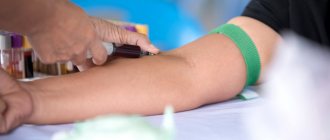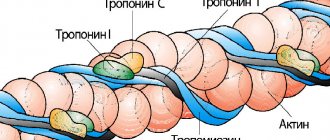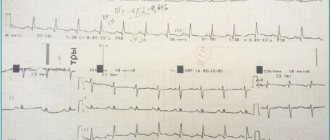C-reactive protein test: what is it for?
What is C-reactive protein? What can a test result for this substance tell a doctor? What is the normal level of C-reactive protein in the blood? Nikita Valerievich Vorobyov, a neurologist at the Expert Clinic Kursk, answers these and other questions.
— Nikita Valerievich, before we talk about the analysis for C-reactive protein, please tell us what kind of substance this is? Is it present in the body normally or does it appear only during certain diseases? And what is the significance of the C-reactive protein test?
— C-reactive protein is a kind of indicator of various diseases, the most sensitive marker of the inflammatory process. With its help, the doctor can determine the severity of inflammation in the body. This substance is synthesized by liver cells in response to inflammatory processes in the body: during tissue damage, cell necrosis, during an infectious process, during exacerbation of chronic diseases, for example, rheumatological ones, including ankylosing spondylitis.
Being in the body within normal concentrations, C-reactive protein has a protective function: it initiates immune processes, stimulates phagocytosis (a process in which special blood cells and body tissues - phagocytes - capture and absorb various foreign structures, such as destroyed cells, bacteria, antigen-antibody complexes, etc.).
When the content of C-reactive protein in the blood begins to exceed the norm, this indicates some kind of inflammatory process, the nature of which the doctor will have to find out. Moreover, during acute inflammation, the content of C-reactive protein increases very quickly, literally in 6 hours. Much faster than, for example, ESR changes - the erythrocyte sedimentation rate.
When the treatment itself has already begun, an analysis for C-reactive protein helps the doctor understand what phase the pathology is in: is the acute period still ongoing or the disease has declined.
— What is the normal level of C-reactive protein in the blood?
- Depending on the laboratory, the norm of C-reactive protein varies from 0 to 1 milligram per liter and from 0 to 5 milligrams per liter. There is no lower limit of normal; this protein is detected in the blood only in response to acute inflammation. Within acceptable limits, the level of C-reactive protein can fluctuate during physical activity (for example, after playing sports), smoking, or eating fatty foods.
- Then, it turns out, there is no point in asking under what circumstances C-reactive protein can be lowered? Is this question not valid?
- Right. There are two options: either the protein is normal, or its content is increased. There can be no reduction.
— Why can C-reactive protein be elevated?
— I have already partially answered this question: its content increases with the appearance of inflammatory processes in the body. The reasons for the increase in C-reactive protein may be:
- previous trauma, burn;
- rheumatological disease;
- presence of infection;
- transplant rejection reaction.
The content of this protein also increases during myocardial infarction, after undergoing severe operations.
An analysis for C-reactive protein - I repeat, as an auxiliary study - is used if there is a risk of developing cardiovascular complications, in particular, when diagnosing atherosclerosis: with inflammation of the vascular walls, the concentration of this protein also increases.
— Tell me, how does C-reactive protein behave during pregnancy?
— Since pregnant women have a higher immune system tension than non-pregnant women and, even more so, than men, the content of C-reactive protein during this period may be increased. If the woman is healthy and gestation is normal, this indicator increases from the 16th to the 28th week of pregnancy, then gradually begins to decrease. Then it may increase immediately before childbirth. A high concentration of C-reactive protein in the blood may indicate a risk of developing late toxicosis.
— Which doctor and under what circumstances prescribes a test for C-reactive protein? What might be the reason for this research?
— A general practitioner, therapist, or neurologist can refer a patient for this analysis. But, since this type of research is primarily used in the diagnosis of rheumatological diseases, most often this direction is issued by a rheumatologist.
An analysis for C-reactive protein is carried out, for example, if ankylosing spondylitis is suspected. When making a diagnosis, this study plays an auxiliary role; it is used in conjunction with other markers. When ankylosing spondylitis has already been detected, the doctor can determine by the concentration of C-reactive protein what phase the disease is in - in the stage of exacerbation or remission (the period of weakening or disappearance of the symptoms of the disease).
This test is also prescribed for joint pain, increased body temperature, and infectious processes.
Neurologists use this type of analysis to understand the nature of a patient's back pain.
— Do you always need a referral from a doctor to get tested for C-reactive protein? And if not, what is more correct: to take it as directed or on your own initiative?
— Having a referral for such an analysis is not a prerequisite. But it is still better to do any research after consulting a doctor.
— Does the patient need to somehow prepare for the C-reactive protein test?
— The procedure is a simple blood draw from a vein. No special preparation is required from the patient. The generally accepted rules in such cases apply. The test is taken on an empty stomach, after a 12-14 hour fast (usually this is done in the morning). The day before, 24 hours before the test, you need to avoid drinking alcohol and intense physical activity. It may be necessary to temporarily stop taking certain medications, but only after consultation with your doctor.
1-2 hours before the test, you need to refrain from smoking, tea, coffee, and juices. You can drink still water. Running and quick climbing of stairs should be avoided. It is not recommended to do the study after emotional stress or severe anxiety.
— How long should I wait for the test result?
- Usually no more than one day.
Interviewed by Igor Chichinov
Want to learn more about other tests? Read articles in our “Laboratory Tests” section If you need to get tested for C-reactive protein or other tests, you can sign up here You can make an appointment with specialists here ATTENTION: services are not available in all cities
The editors recommend:
Pain with rheumatoid arthritis: how to help the patient? Are you worried about pain in your lower back? We're talking about sacroiliitis Are you crunchy? What will an MRI of joints tell you?
For reference:
Vorobiev Nikita Valerievich
Graduate of the Faculty of Medicine of Kursk State Medical University in 2021. In 2021, he completed his residency at Kursk State Medical University in the direction of Neurology. Advanced training: interventional methods of treatment in neurology, First Moscow State Medical University named after. THEM. Sechenova, 2021. Advanced training: local therapy of diseases of the musculoskeletal system and compression-neural syndromes, Kursk State Medical University, 2021. Currently, a neurologist at the Expert Clinic Kursk. Receives at the address: st. Karl Liebknecht, 7.
Functions
The synthesis of C-reactive protein is carried out by liver cells (hepatocytes) under the influence of pro-inflammatory cytokines to perform the protective functions of the body:
- binds substances (polysaccharides, nucleic acids, polyanions) located on the surface of bacteria, fungi and parasites;
- activates the work of immune system enzymes for nonspecific protection against infectious processes;
- promotes phagocytosis - the capture and destruction of foreign cells by macrophages, microphages and monocytes;
- activates the work of platelets during bleeding;
- identifies, neutralizes and removes toxic substances formed during the breakdown of its own cells.
Causes of the disease
The main causes of reactive arthritis are past infection and genetic predisposition. Infections that can cause ReA include:
- urogenital form of ReA
– chlymydia, ureaplasmosis, mycoplasmosis; - intestinal form of ReA
– shigenellosis (dysentery), salmonellosis, yersiniosis, intestinal infection caused by Escherichia coli; - nasopharyngeal form
– previous nasopharyngeal infections caused by staphylococcal, streptococcal and other infections.
A previous infection is a trigger (triggering factor) that starts a chain of immuno-allergic and inflammatory reactions. This occurs predominantly in genetically predisposed individuals who have the HLA-B27 antigen in their body, which causes an imbalance in the immune system, which leads to increased formation of prostaglandins and cytokines - biologically active substances that cause inflammation.
A long-term inflammatory process is also supported by incompletely removed infectious pathogens and the appearance of antibodies to them. Reactive arthritis caused by urogenital infection (chlamydia, mycoplasma, ureaplasma), which penetrates cells and remains viable for a long time, takes a particularly long time. Failures in the immune system cause allergic and autoimmune (allergy to the body's own tissues) processes, which also support long-term inflammation.
Possible localization of inflammation
In intestinal and urogenital forms of reactive arthritis, the joints of the lower extremities are most often affected. In the nasopharyngeal form - the joints of the upper extremities and the temporomandibular joint.
Arthritis of the lower extremities
Affection of the lower extremities predominantly begins with the big toes and moves upward (staircase sign), affecting the overlying joints asymmetrically. In reactive arthritis, one to five joints become inflamed:
- interphalangeal toes; Most often the first toe is affected, it swells and turns red - the “sausage toe” symptom;
- ankles with damage to surrounding tissues; Particularly characteristic is damage to the tendons and ligaments in the heel area with the formation of loose heel spurs, which causes constant pain that intensifies when walking and stepping on the heel;
- knee – this location is characterized by the formation of a large amount of exudate (inflammatory fluid in the joint), which leads to the formation of popliteal cysts; rupture of cysts leads to the development of thrombophlebitis and impaired venous circulation;
- hip – rarely affected, occurs in the form of moderate joint pain.
Chondroprotectors: what are they, how to choose, how effective are they?
Joint pain at rest
Arthritis of the upper extremities
Localization of reactive arthritis in the joints of the upper extremities is much less common. This mainly occurs in diseases of the nasopharynx and dental infectious and inflammatory processes.
The most common joints affected by ReA are:
- elbow - the elbow swells, turns red, becomes painful, the arm has difficulty bending and unbending;
- wrist with damage to the ligaments and tendons of the hand - pain in the joint is transmitted to the hand; severe pain does not allow you to squeeze and unclench your hand or hold objects in it;
- shoulder – rarely affected, characterized by swelling and pain.
Temporomandibular arthritis
Reactive arthritis affects the joints of the lower and upper extremities, temporomandibular joints
Triggers include infections of the nasopharynx, ear and mouth. Characterized by slight swelling, redness and swelling in the area of development of reactive arthritis. When opening the mouth, there is a slight asymmetry; the chewing process may be disrupted and become painful. The disease occurs acutely or subacutely, is well treated, and the prognosis is favorable.
What it is?
C-reactive protein is a two-component molecule consisting of proteins (peptides) covalently linked to several oligosaccharides. The name is due to its ability to interact with C-polysaccharides of bacteria of the Streptococcaceae family, thereby forming a stable antigen-antibody complex (precipitation reaction). This mechanism refers to the protective reactions of the human body to infectious infection.
When a pathogen penetrates, the immune system is activated, which stimulates the process of synthesis of small peptide molecules - cytokines. They provide signal transmission about the manifestation of the inflammatory process and the need to enhance the production of acute phase proteins, which are CRP. After 1-2 days, there is an increase in CRP by tens and hundreds of times compared to normal values.
No. 3. CRP to determine the need for urgent kidney drainage
It is highly doubtful that the decision about the need for kidney drainage should be based on the level of CRP. But Angulo JC made such an attempt and published the results of his study in the journal Urology in 2010. The study involved 110 patients with renal colic, 29 of whom underwent emergency kidney drainage. The mean CRP level in patients who required drainage was 140 mg/L. The average level of CRP in patients who did not require drainage was significantly lower – 15 mg/l. The cut-off point was 28 mg/l. The authors conclude that determination of CRP levels in patients with renal colic is an objective and useful tool for deciding whether to place a ureteral stent, even more valuable than leukocyte expression or serum creatinine levels.
Indications for use
Analysis for C-reactive protein is part of a set of diagnostic measures and is prescribed to identify the following diseases and pathological conditions:
- parasitic, bacterial and viral infections;
- tumors;
- oncological processes;
- assessing the degree of tissue necrosis as a result of injuries, burns, destructive changes in internal organs;
- early detection of postoperative complications;
- diagnosis of transplant rejection;
- assessment of the condition during myocardial infarction;
- tracking the results of therapy for rheumatoid processes;
- determination of cardiovascular risk;
- the effectiveness of antibacterial, anti-inflammatory treatment, immunosuppressive therapy;
- neonatal sepsis.
General clinical recommendations
In the acute and subacute course of ReA, after a course of treatment, the patient should be under the supervision of a rheumatologist for six months with clinical and laboratory monitoring every 3 months.
In the chronic course of the disease, dispensary observation is longer with the prescription of courses of anti-relapse therapy until a state of stable remission appears.
After an illness, it is recommended to avoid heavy physical activity and strength sports. Swimming is a good way to restore joint function.
Persons with a genetic predisposition (presence of the HLA-B27 antigen) to reactive arthritis are recommended to have one proven sexual partner.
We combine proven techniques of the East and innovative methods of Western medicine.
Read more about our unique method of treating arthritis









